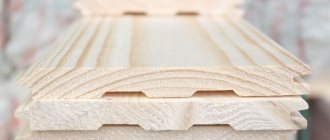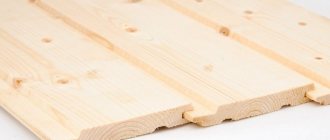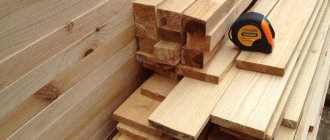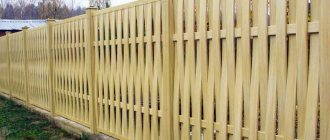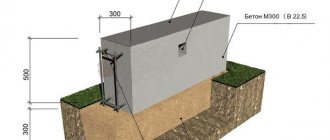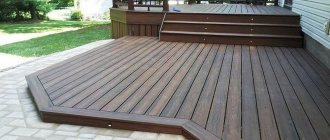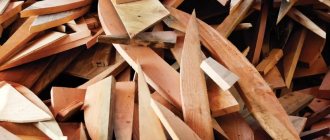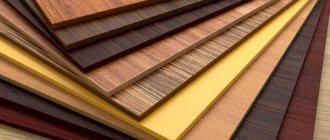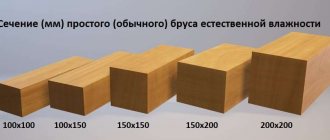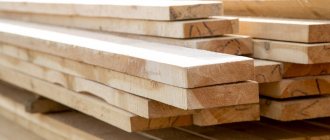The abbreviation “inch board” appeared due to the fact that the thickness of such lumber is 25.0 mm, and the inch, which is a non-metric unit of measurement of distance and length, is 25.4 mm.
Edged boards are the material most often used in construction. The most common is the inch board, the dimensions of which allow it to be used both in roof sheathing and in furniture production. What do you need to know about this material?
Standard dimensions for “inches” are 25x100x6000, 25x150x6000, 25x200x6000 millimeters (most often in construction, a board with a width of 150 mm is used). Models 25x100 mm can have other lengths. As already mentioned, inch boards are 2.5 cm thick.
How many 6 meters long boards are there in one cube?
- How many edged boards are in 1 cube?
- Number of unedged boards
- How to calculate?
When purchasing one of the most popular building materials - boards - you cannot do without knowing how many of them are contained in a cubic meter. After all, boards are measured in cubic meters, and sellers usually indicate the price for a given unit of volume. And calculations for construction, for example, how much material is needed for wall cladding, building a bathhouse or repairing a fence, are usually made in pieces.
In the article, we will look at how to quickly find out, using cube tables, how many pieces of edged and unedged boards of different sizes with a standard length of 6 m are contained in a cubic meter, and how to calculate the necessary numbers yourself for lumber of non-standard dimensions, or if there is no table at hand.
Varieties of inch boards
The parameters for evaluating inch boards are the same as for other boards: grade, processing method, humidity level and many other factors.
One of the most important factors is the type of wood . This indicator describes what defects and in what quantity a material may have and how this affects its properties.
- Extra – or selected. Such an inch with a length of 6 m does not contain cracks, knots, or stains. The wood is very clean.
- Grade 1 – non-through cracks, pockets and captive knots are allowed, in an amount of no more than 2 per 1 linear meter of board. 1st grade is practically not inferior to selected, but at the same time noticeably cheaper.
- Grade 2 - such lumber includes deep, but not through cracks, 2 resinous pockets and fallen knots per 1 running meter, spots and stripes are allowed to appear - not blue. Loose knots may also occur.
- Grade 3 – 1 linear meter has pockets, knots, including fallen ones, and stains. Chips and individual through cracks are allowed. The material is used for packaging, pallets, and in the construction of formwork. It cannot be used for loaded structures - low load-bearing capacity.
- Grade 4 - rot spots, colored stripes, fused and fallen knots, deep through cracks, wane are acceptable. This material is used for the construction of sheds and outbuildings.
The cost of graded material depends on the cleanliness of the board and the nature of the wood itself.
Wood species
The characteristics of wood, such as resistance to moisture, strength, durability in certain conditions, are determined not by the size, but by the characteristics of the wood. Inch gauge made from pine or oak has different qualities.
The material is cut from coniferous and leaf wood. The most popular conifers:
- Pine is the most popular material due to its low cost and availability. The rock is relatively soft, but durable; it is used in building structures without restrictions. Contains a large amount of resins, which protects it from the direct action of moisture and increases resistance to dampness. However, this resistance is not so high as to leave the tree without protection.
- Larch – with less resin content, is extremely resistant to water and dampness. Moreover, under the influence of moisture it only becomes stronger. Wood is used to make window frames, doors, decking, gazebos and other external structures. It is better not to use larch for roofing: the material conducts heat well.
- Spruce is a lumber that is not inferior to pine in its resistance to moisture and fungus, but is less resinous. It is most often offered in the form of boards, since it shrinks greatly when dried.
- Cedar is an expensive, hard, durable tree, very beautiful and fragrant. Cedar can withstand heavy loads and is durable, which is why it is often used in the construction of critical components, as well as for cladding residential premises and saunas.
Spruce
Cedar
Larch
Pine
Hardwood species include:
- Linden is a soft, silky, beautiful wood that emits a wonderful aroma. Its main difference is its low heat conductivity: even at temperatures of 100°C it does not heat up. Linden boards are used primarily for finishing saunas and baths.
- Ash is a medium-density species that holds carvings well. The wood is light, beautiful, beautifully painted and treated with stains or paints. The board is very uniform, which makes ash a stable element. Thumbelina is used for flooring and staircase construction.
- Oak is a medium-density wood, quite difficult to process, and very beautiful. The material is completely insensitive to dampness; direct contact with water only becomes harder. Due to its high tannin content, oak can last for centuries.
Ash
Oak
Linden
Other types of wood are also used, but mostly dense or medium density.
Edged and unedged
An unedged board is obtained by cutting the trunk. In this case, the ends are not processed and the bark is not removed . The appearance is not presentable, but the cost is lower. There are 2 subspecies:
- fence - made of low quality lumber, with knots and cracks, - not intended for loads;
- carpentry - made from grade 1-2 wood and used in construction.
Inch edged board - produced by cutting processed logs. There is no wane on the ends and edges , and the unfinished edge is considered a defect. The characteristics of the board depend on the method of cutting the trunk :
- radial cut board - cut from the middle of the trunk, practically does not shrink and dries well;
- semi-radial - obtained by cutting a log at 45 degrees and a grade slightly lower;
- tangential inch - cut out in areas away from the center, gives noticeable shrinkage and has a pronounced texture.
Tangential cutting allows you to obtain the largest possible number of boards.
How many edged boards are in 1 cube?
An edged board is a wood material, sawn on all sides along the faces and edges; it has a rectangular cross-section and straight, even edges. Due to its shape, it fits tightly into stacks with a minimum number of gaps. Therefore, the number of edged boards of a certain size in a cube is always standard - for example, 25x150x6000 boards will always be 44 units, and 50x150x6000 boards will always be 22. Thus, for edged boards of popular standard sizes, you can not do the same calculations every time, but use ready-made tables - cubic meters, where the volume of the board and the number of its units per cubic meter (cubic capacity) are indicated.
From the tables it is easy to find out that the following amount of boards with a standard length of 6 meters is contained in a cubic meter.
Thickness 20 millimeters (twenty):
- 100 mm wide – 83 pieces;
- width 120 mm – 69 pieces;
- 150 mm wide – 55 pieces;
- width 180 mm – 46 pieces;
- 200 mm wide – 41 pieces;
- 250 mm wide – 33 pieces.
Thickness 25 millimeters (twenty-five):
- 100 mm wide – 66 pieces;
- width 120 mm – 55 pieces;
- 150 mm wide – 44 pieces;
- width 180 mm – 37 pieces;
- 200 mm wide – 33 pieces;
- 250 mm wide – 26 pieces.
Thickness 30 millimeters (thirty):
- 100 mm wide – 55 pieces;
- width 120 mm – 46 pieces;
- 150 mm wide – 37 pieces;
- width 180 mm – 30 pieces;
- 200 mm wide – 27 pieces;
- 250 mm wide – 22 pieces.
Thickness 32 millimeters (thirty-two):
- 100 mm wide – 25 pieces;
- 120 mm wide – 43 pieces;
- 150 mm wide – 34 pieces;
- width 180 mm – 28 pieces;
- 200 mm wide – 26 pieces;
- 250 mm wide – 20 pieces.
40 millimeters thick (forty):
- with a side of 100 mm - 41 pieces;
- with a side of 120 mm - 34 pieces;
- with a side of 150 mm – 27 pieces;
- with a side of 180 mm - 23 pieces;
- with a side of 200 mm – 20 pieces;
- with a side of 250 mm - 16 pieces.
Thickness 50 millimeters (fifty):
- with a side of 100 mm - 33 pieces;
- with a side of 120 mm - 27 pieces;
- with a side of 150 mm - 22 pieces;
- with a side of 180 mm - 18 pieces;
- with a side of 200 mm - 16 pieces;
- with a side of 250 mm - 13 pieces.
It is important to note that for tongue-and-groove types of material (lining, blockhouse, imitation timber, flooring), which have protrusions and grooves for a more durable joining, calculations are carried out only for the working (visible) width, without taking into account tenons. Therefore, the same cubeturns are suitable for them as for edged boards.
Number of unedged boards
An unedged board is a material sawn along two opposite layers; the edges remain uncut, preserving the bark (wane), and have a beveled or rounded shape. The end part has the shape of a trapezoid . Therefore, such parts cannot be laid as tightly as rectangular materials; accordingly, the number of unedged materials in a cube will always be less than trimmed ones.
But the main difference from edged boards is that their length and thickness are standardized, and their width is individual and depends on what part of the tree the part was cut from and what the original diameter of the trunk was. Therefore, unedged materials differ greatly from each other in width. Consequently, the volume of each board in the batch varies slightly. Namely, the number of units per cubic meter depends on this indicator. Consequently, it is more difficult to calculate the number of unedged materials in a cube than trimmed ones.
Classification and characteristics
At a woodworking factory, a log is cut into unedged boards. This material is cheaper than edged material, but additional processing is required. If you cut off the side edges along with the bark, you get an edged board. Its thickness varies, the most common being 25 mm or 1 inch. Hence the name “inch”. The width is 100, 150 and 200 mm, the length is 6, less often 4 meters.
Depending on the quality, inch wood has 5 grades; the classification for coniferous species is based on GOST 8486-86. Hardwood board has 4 grades. According to the scope of application, varieties can be divided into three groups:
- higher;
- first and second;
- third and fourth.
Inch gauge of the highest grade of coniferous species is used in the construction of sea and river vessels. It is not used in the construction of houses due to its high cost.
The first and second grades of wood are used in interior decoration and furniture production.
The third and fourth grades are used in the construction of roofing (sheathing for metal profiles, tiles), for foundation formwork, rough filing of ceilings and floors, fences and fences, temporary structures.
In addition to thickness, the parameters characterizing this material are: The initial raw materials are coniferous trees (spruce, pine), as well as aspen and birch. The use of these tree species is due to their relatively low cost and availability.
More expensive species (cedar, larch, oak, beech) are also used in the manufacture of inch wood, if this is due to the need to use more durable material, both for interior decoration and for the construction of building structural elements.
Width - depends on the geometric dimensions of the raw materials used (diameter of tree trunks). Woodworking enterprises produce inch boards with a width of 75.0/100.0/150.0/200.0 mm. Length - depends on the customer’s needs and the technical capabilities of the equipment on which the board is made. In industrial production, inch boards are produced in lengths of 2.0/4.0/6.0 meters.
In construction stores, inches are sold by cubic meters. The number of boards will depend on dimensions such as length and width.
| Width, mm | Quantity of material pcs/m³ | Board volume m³ | Board area m² |
| 100 | 66 | 0,014 | 0,5 |
| 120 | 55 | 0,017 | 0,7 |
| 150 | 44 | 0,0224 | 0,8 |
| 180 | 37 | 0,026 | 1 |
| 200 | 33 | 0,04 | 1,3 |
A conscientious manufacturer and seller will provide this information to the client. Otherwise, the area of an inch and its quantity per cubic meter can be calculated using special formulas.
The dimensions of the inch board can be different:
its width ranges from 75 mm to 250 mm; length can be from 2000 mm to 6000 mm with a gradation of 250 mm.
Only the thickness remains unchanged - 25 mm. Knowing the length, width and height of the board, you can easily calculate its cubic capacity or calculate the required area.
When constructing private houses, a small board is used at almost all stages of construction. The inch board combines low thickness and weight with high strength. Therefore, structures made from such wooden products are very light and reliable. This made the board very popular in construction.
More often it is used:
- for lathing on pitched roofs as a base for roofing material;
- in the form of formwork for pouring the concrete foundation of a house;
- for frame house construction in combination with timber;
- for subfloors as a base for insulation or laminate;
- for knocking down small stairs;
- when erecting fences;
- as cladding for outbuildings.
An inch piece of wood has a low cost compared to other, thicker wood products. Therefore, sometimes, in order to save money, craftsmen come up with the idea of nailing 2-3 inch boards together, imitating expensive thick wood.
How to calculate?
Cubes are not available for all sizes of edged and unedged boards. Therefore, it is important to be able to make all the calculations yourself. To find out how many units of edged boards of the required sizes are contained in a cubic meter, you need to make calculations.
- Calculate the volume of one part using the formula length*width*height. You can also use the GOST 5306-83 table, which shows the volume for the main standard sizes of lumber.
- Calculate using the formula 1 m3/V, where V is the volume of one board. Calculations are made in common units - meters, and it is important not to forget to convert all dimensions into them.
- The remainder of the division is discarded, the resulting integer value is the number of pieces per cubic meter.
For example, to calculate how many 25×150×6000 edged boards are in a cubic meter:
- let's calculate the volume of one part - 0.025 × 0.15 × 6 = 0.0225 m3;
- substitute the value into the formula 1 m3/V – 1/0.0225 = 44.444;
- discarding the remainder, we find that there are 44 boards in the cube measuring 25 × 150 × 6000.
In the same way, you can calculate the cube of not only a 6-meter edged board, but also any lumber with a rectangular or square cross-section and smooth edges - timber, bars, lining, edged, sanded or profiled boards of any size (2, 3, 4 meters and others).
Counting the number of unedged boards in a cube is a more difficult task, since their peculiarity is a large spread in width, due to which they have different volumes. If you simply substitute the volume of one randomly taken board from a batch into the formula 1 m3/V, the result will be very inaccurate. Therefore, before making calculations, you need to calculate the arithmetic average volume of the board in the batch. In accordance with GOST, it can be determined in three ways.
The first one is piecemeal. The calculation is carried out in several stages.
- Measure the dimensions of each board without taking into account the bark (measurement data is rounded to 10, and values up to 5 mm are not taken into account).
- The width is measured for each of the two layers in the center, then the arithmetic mean of the width is calculated. Moreover, if the moisture content of the material is more than 20%, GOST recommends making adjustments for width shrinkage. To do this, you need to multiply the average width of a part made from coniferous species by a factor of 0.96, from hardwood – by a factor of 0.95.
- Calculate the volume of each part using the formula length*average width*height.
- Calculate the arithmetic average volume of the board in the batch.
This is the most accurate, but also the most labor-intensive method. It is used for small batches of material.
The second method is selective. It is similar to piece-by-piece, only the dimensions of not all boards are measured, but selectively of a certain number from the batch. How much material needs to be taken for sampling is determined in accordance with GOST 13-24-86. For example, for a batch where all materials are the same length, the sample should be at least 3% and at least 60 units.
The third method is batch.
- The dimensions of the packaging (package) in which a batch of a certain number of boards is placed are measured.
- The volume of the package is calculated using the formula length * width * height.
- For accurate calculations, it is necessary to take into account that due to the beveled edges, the boards cannot be placed tightly, and there are gaps between them. To recalculate the measured (folded) volume of the package into the volume of a dense cube, you need to apply correction factors that are given in GOST 13-24-86.
- To find out the volume of one board, you need to divide the resulting volume by the number of boards in the batch.
Tips for choosing
Before purchasing such boards, it is worth considering some important nuances of choice. Remember that these lumber can be kiln dried or naturally dried. Models that undergo special drying in a chamber equipped for this are considered more reliable and durable.
Pay attention to the appearance of the products. They must be absolutely smooth. If the samples are twisted, then we can say that the workpieces were improperly dried - such models should not be used in construction work.
Before purchasing, you should pay attention to the evenness of the cut. Check the surface of the wood for any insect damage. Check that there are no scratches or chips on the boards. The presence of various defects on the lumber must correspond to the specified grade.
Sizing is also important. It is this parameter that must be calculated to determine the required amount of lumber. As a rule, the number of boards is measured in cubic meters - this value is the sum of the length, width and thickness of such wooden structures.
It is recommended to look at the strength level of the wood. It can be identified by the growth rings on the surface of the material. The older the tree, the stronger the building structures it will be. With age, the growth rings on wood begin to narrow, so models in which they are placed as close to each other as possible are the most aged and durable.
Site articles on the topic
- Plastic plumbing hatch: dimensions and choice of options
- Standard sizes of interior doors. Dimensions of doors with frames, openings
- Edged board. Main varieties, their characteristics and applications
- DIY board fence
- Which floor covering to choose. Parquet or laminate?
You may also find the following materials useful:
- Manifold cabinets. Types and features
- What types of lumber are there?
- How to build a house from timber with your own hands
- Country houses made of timber
- Suitable materials for building a house
How many pieces of edged and planed boards are in 1 cube table
| Dimensions , mm | Volume of boards in 1 m 3 | Number of boards per m3 | Number of boards per m2 |
| 20x100x6000 | 0.012 m 3 | 83 pcs. | 50 m2 |
| 20x120x6000 | 0.0144 m 3 | 69 pcs. | 50 m2 |
| 20x150x6000 | 0.018 m 3 | 55 pcs. | 50 m2 |
| 20x180x6000 | 0.0216 m 3 | 46 pcs. | 50 m2 |
| 20x200x6000 | 0.024 m 3 | 41 pcs. | 50 m2 |
| 20x250x6000 | 0.03 m 3 | 33 pcs. | 50 m2 |
| 25x100x6000 | 0.015 m 3 | 67 pcs. | 40 m2 |
| 25x120x6000 | 0.018 m 3 | 55 pcs. | 40 m2 |
| 25x150x6000 | 0.0225 m 3 | 44 pcs. | 40 m2 |
| 25x180x6000 | 0.027 m 3 | 37 pcs. | 40 m2 |
| 25x200x6000 | 0.03 m 3 | 33 pcs. | 40 m2 |
| 25x250x6000 | 0.0375 m 3 | 26 pcs. | 40 m2 |
| 30x100x6000 | 0.018 m 3 | 55 pcs. | 33 m2 |
| 30x120x6000 | 0.0216 m 3 | 46 pcs. | 33 m2 |
| 30x150x6000 | 0.027 m 3 | 37 pcs. | 33 m2 |
| 30x180x6000 | 0.0324 m 3 | 30 pcs. | 33 m2 |
| 30x200x6000 | 0.036 m 3 | 27 pcs. | 33 m2 |
| 30x250x6000 | 0.045 m 3 | 22 pcs. | 33 m2 |
| 32x100x6000 | 0.0192 m 3 | 52 pcs. | 31 m2 |
| 32x120x6000 | 0.023 m 3 | 43 pcs. | 31 m2 |
| 32x150x6000 | 0.0288 m3 | 34 pcs. | 31 m2 |
| 32x180x6000 | 0.0346 m³ | 28 pcs. | 31 m2 |
| 32x200x6000 | 0.0384 m 3 | 26 pcs. | 31 m2 |
| 32x250x6000 | 0.048 m 3 | 20 pcs. | 31 m2 |
| 40x100x6000 | 0.024 m 3 | 41 pcs. | 25 m2 |
| 40x120x6000 | 0.0288 m3 | 34 pcs. | 25 m2 |
| 40x150x6000 | 0.036 m 3 | 27 pcs. | 25 m2 |
| 40x180x6000 | 0.0432 m 3 | 23 pcs. | 25 m2 |
| 40x200x6000 | 0.048 m 3 | 20 pcs. | 25 m2 |
| 40x250x6000 | 0.06 m 3 | 16 pcs. | 25 m2 |
| 50x100x6000 | 0.03 m 3 | 33 pcs. | 20 m2 |
| 50x120x6000 | 0.036 m 3 | 27 pcs. | 20 m2 |
| 50x150x6000 | 0.045 m 3 | 22 pcs. | 20 m2 |
| 50x180x6000 | 0.054 m 3 | 18 pcs. | 20 m2 |
| 50x200x6000 | 0.06 m 3 | 16 pcs. | 20 m2 |
| 50x250x6000 | 0.075 m 3 | 13 pcs. | 20 m2 |
Board calculation formulas
Examples of calculations for boards measuring 20x100x6000 mm
Formula for calculating the volume of a board: 0.02 m · 0.1 m · 6 m = 0.012 m 3
Formula for calculating boards in a cube in pieces: 1 m3 / 0.012 m3 = 83 pieces/m3
Formula for calculating a board in a cube in squares: 1 m 3 / 0.02 m = 50 m 2 / m 3
To decide how many boards are in 1 cube, you first need to know the basic parameters of the purchased material - thickness, width and length. You can also make calculations for boards measuring 3 meters, 4 meters, 5 meters.
The page contains answers to simple questions from people:
- How many boards
- How many board cubes
- How many pieces of boards
- Boards in a cube
- How many cubes are there in the boards?
- How many pieces in one cube
- How many edged boards per cube?
- How to count how many boards are in 1 cube
Why count how many boards are in 1 cube?
There are only two reasons to make calculations:
- You will find out the total price of the entire volume of timber needed for your project. It is enough to know the price for 1 board and how many pieces there are (determined by calculation or from our table for standard board sizes).
- You will calculate the total number of boards needed to complete your project. And you can make a calculation by knowing how many cubes of material are needed for the work, and by determining the number of pieces of boards in 1 cube.
Lumber sizes
The dimensions of edged boards of 25 mm are regulated by GOST. There are different standards for sawn timber of coniferous and deciduous species: for coniferous – GOST 24454-80, for deciduous – 2695-83.
The standards are set for wood with a moisture content of 20%.
Coniferous GOST
| Thickness | Width | ||||||||
| 16 | 75 | 100 | 125 | 150 | — | — | — | — | — |
| 19 | 75 | 100 | 125 | 150 | 175 | — | — | — | — |
| 22 | 75 | 100 | 125 | 150 | 175 | 200 | 225 | — | — |
| 25 | 75 | 100 | 125 | 150 | 175 | 200 | 225 | 250 | 275 |
| 32 | 75 | 100 | 125 | 150 | 175 | 200 | 225 | 250 | 275 |
| 40 | 75 | 100 | 125 | 150 | 175 | 200 | 225 | 250 | 275 |
| 44 | 75 | 100 | 125 | 150 | 175 | 200 | 225 | 250 | 275 |
| 50 | 75 | 100 | 125 | 150 | 175 | 200 | 225 | 250 | 275 |
| 60 | 75 | 100 | 125 | 150 | 175 | 200 | 225 | 250 | 275 |
| 75 | 75 | 100 | 125 | 150 | 175 | 200 | 225 | 250 | 275 |
| 100 | — | 100 | 125 | 150 | 175 | 200 | 225 | 250 | 275 |
| 125 | — | — | 125 | 150 | 175 | 200 | 225 | 250 | — |
| 150 | — | — | — | 150 | 175 | 200 | 225 | 250 | — |
| 175 | — | — | — | — | 175 | 200 | 225 | 250 | — |
| 200 | — | — | — | — | — | 200 | 225 | 250 | — |
| 250 | — | — | — | — | — | — | — | 250 | — |
Deciduous GOST
length dimensions are determined as follows:
- from hard hardwood - from 50 cm to 6.5 m in increments of 10 cm;
- from soft varieties and birch - from 0.5 to 2 m in increments of 10 cm;
- from 2 to 6.5 m in increments of 24 cm;
- thickness ranges from 19 to 100 mm including 25 mm;
The width depends on the type of board:
- edged - from 60 to 110 cm in increments of 10 cm and from 130 to 200 in increments of 20–30 cm;
- unedged or edged on one side - from 50 or more in increments of 1 cm.
cubic capacity and weight
Inch gauge is offered in linear meters and or in cubes. To avoid manual calculations, use ready-made tables.
| Dimensions, mm | Volume of boards, m³ | Number of boards in 1 cube, pcs. | Number of boards per m² |
| 25x100x6000 | 0,015 | 67 | 40 |
| 25x120x6000 | 0,018 | 55 | 40 |
| 25x150x6000 | 0,0225 | 44 | 40 |
| 25x180x6000 | 0,027 | 37 | 40 |
| 25x200x6000 | 0,03 | 33 | 40 |
| 25x250x6000 | 0,0375 | 26 | 40 |
How many boards are in a cube - table for 6-meter boards.
| Board dimensions, mm | Volume of one board, m 3 | Number of boards per cubic meter (m3) | Square meters in one cube (m2) |
| 20mm (twenty) | |||
| 20x100x6000 | 0.012 m 3 | 83 pcs. | 50 m2 |
| 20x120x6000 | 0.0144 m 3 | 69 pcs. | 50 m2 |
| 20x150x6000 | 0.018 m 3 | 55 pcs. | 50 m2 |
| 20x180x6000 | 0.0216 m 3 | 46 pcs. | 50 m2 |
| 20x200x6000 | 0.024 m 3 | 41 pcs. | 50 m2 |
| 20x250x6000 | 0.03 m 3 | 33 pcs. | 50 m2 |
| 25mm (twenty-five) | |||
| 25x100x6000 | 0.015 m 3 | 67 pcs. | 40 m2 |
| 25x120x6000 | 0.018 m 3 | 55 pcs. | 40 m2 |
| 25x150x6000 | 0.0225 m 3 | 44 pcs. | 40 m2 |
| 25x180x6000 | 0.027 m 3 | 37 pcs. | 40 m2 |
| 25x200x6000 | 0.03 m 3 | 33 pcs. | 40 m2 |
| 25x250x6000 | 0.0375 m 3 | 26 pcs. | 40 m2 |
| 30mm (thirty) | |||
| 30x100x6000 | 0.018 m 3 | 55 pcs. | 33 m2 |
| 30x120x6000 | 0.0216 m 3 | 46 pcs. | 33 m2 |
| 30x150x6000 | 0.027 m 3 | 37 pcs. | 33 m2 |
| 30x180x6000 | 0.0324 m 3 | 30 pcs. | 33 m2 |
| 30x200x6000 | 0.036 m 3 | 27 pcs. | 33 m2 |
| 30x250x6000 | 0.045 m 3 | 22 pcs. | 33 m2 |
| 32mm (thirty-two) | |||
| 32x100x6000 | 0.0192 m 3 | 52 pcs. | 31 m2 |
| 32x120x6000 | 0.023 m 3 | 43 pcs. | 31 m2 |
| 32x150x6000 | 0.0288 m3 | 34 pcs. | 31 m2 |
| 32x180x6000 | 0.0346 m³ | 28 pcs. | 31 m2 |
| 32x200x6000 | 0.0384 m 3 | 26 pcs. | 31 m2 |
| 32x250x6000 | 0.048 m 3 | 20 pcs. | 31 m2 |
| 40mm (forty) | |||
| 40x100x6000 | 0.024 m 3 | 41 pcs. | 25 m2 |
| 40x120x6000 | 0.0288 m3 | 34 pcs. | 25 m2 |
| 40x150x6000 | 0.036 m 3 | 27 pcs. | 25 m2 |
| 40x180x6000 | 0.0432 m 3 | 23 pcs. | 25 m2 |
| 40x200x6000 | 0.048 m 3 | 20 pcs. | 25 m2 |
| 40x250x6000 | 0.06 m 3 | 16 pcs. | 25 m2 |
| 50mm (fifty) | |||
| 50x100x6000 | 0.03 m 3 | 33 pcs. | 20 m2 |
| 50x120x6000 | 0.036 m 3 | 27 pcs. | 20 m2 |
| 50x150x6000 | 0.045 m 3 | 22 pcs. | 20 m2 |
| 50x180x6000 | 0.054 m 3 | 18 pcs. | 20 m2 |
| 50x200x6000 | 0.06 m 3 | 16 pcs. | 20 m2 |
| 50x250x6000 | 0.075 m 3 | 13 pcs. | 20 m2 |
The table is compiled for boards 6 meters long (6000mm), as this is the most common size. Everything here is standardized (board sizes). As well as pipe sizes, rolled metal.
How to count how many boards are in a cube
It's best illustrated with an example. Let us need to determine how many 50x150x6000mm boards fit in 1m3. A board size of 50x150x6000mm means that this board is 50mm thick, 150mm wide and 6000mm long. Let's determine its volume using the formula from the school course - multiply the length by the width and by the height. But before that, let's convert millimeters to meters. We find that the volume of one board is 0.05 * 0.15 * 6 = 0.045 m 3. Now we divide 1 cubic meter by the resulting volume and get the number of boards per cubic meter: 1 / 0.045 = 22, (2). Let's round up and get 22 boards.
Or another example - a board 25x150x6000. Let's make the same calculations and get: 1 / (0.025 * 0.15 * 6) = 44.(4) boards or, rounded, exactly 44 pieces .
The same calculation can be repeated for a different size.
